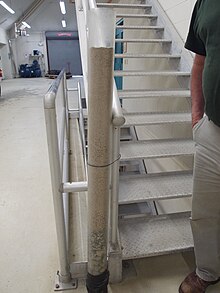
Slow sand filters are used in water purification for treating raw water to produce a potable product. They are typically 1–2 m (3.3–6.6 ft) deep, can be rectangular or cylindrical in cross section and are used primarily to treat surface water. The length and breadth of the tanks are determined by the flow rate desired for the filters, which typically have a loading rate of 200–400 litres (0.20–0.40 m3) per square metre per hour.
Slow sand filters differ from all other filters used to treat drinking water in that they work by using a complex biofilm that grows naturally on the surface of the sand. The sand itself does not perform any filtration function but simply acts as a substrate, unlike its counterparts for ultraviolet and pressurized treatments. Although they are often preferred technology in many developing countries because of their low energy requirements and robust performance, they are also used to treat water in some developed countries, such as the UK, where they are used to treat water supplied to London. Slow sand filters now are also being tested for pathogen control of nutrient solutions in hydroponic systems.